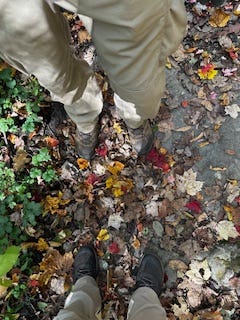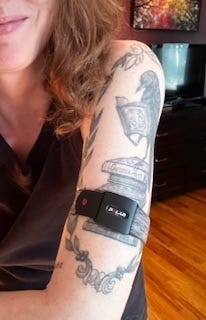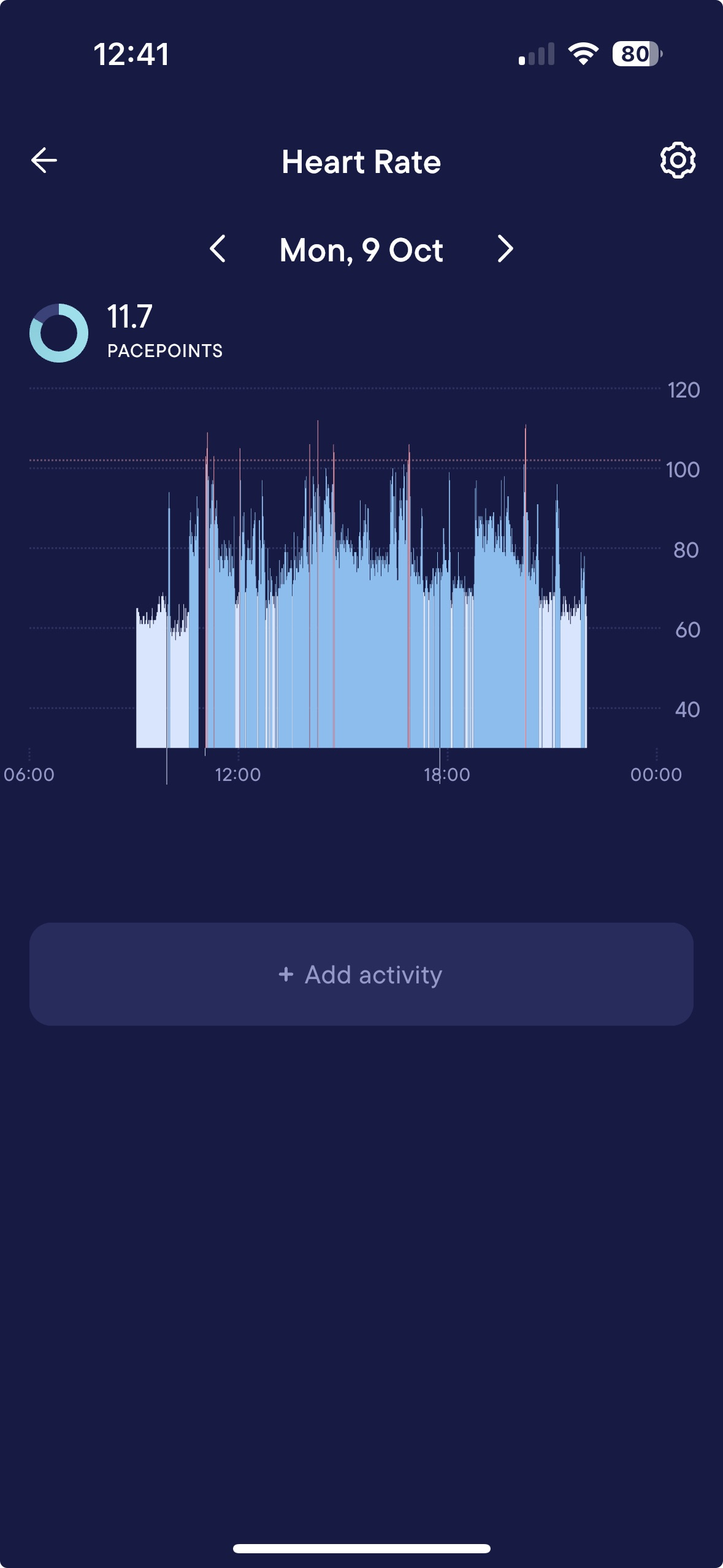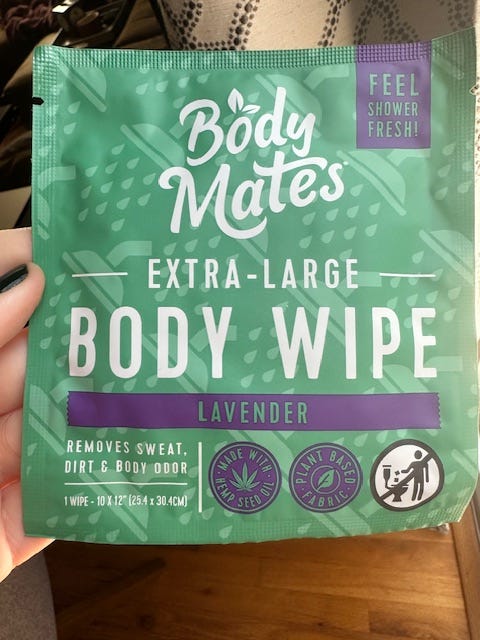Welcome to The Rodeo, my good people - our fortnightly roundup of livestock useful COVID, long COVID, ME/CFS, and other health info.
But first, a funny - you know how we roll here at The Tonic 😆
Giddy up! 🐎 Here we go…
Don’t forget to stick around for (or skip down to) the After-party 🥳.
Visible Plus beta testing
Before we dive into articles and resources, I wanted to fill you all in on my experience these past two weeks beta testing the new Visible Plus pacing tool.
If you’re unfamiliar with Visible, it’s a bunch of awesome blokes from the U.K. who have long COVID and were determined to create an app and a wearable that were not focused on fitness (like FitBits and Garmins are, etc.), but on managing these energy-limiting illnesses.
For many months, I was, and thousands of other long haulers out there were, beta testing the app, which allows you to enter your symptom ratings each day, track your sleep quality, and measure your heart rate variability (HRV) via the camera on your smartphone. (Your HRV is closely aligned with your level of energy/fatigue, so knowing your HRV can be a helpful tool for pacing). The app gives you a morning stability score that takes into account your HRV, your subjective sleep quality, and your symptom scores from the day before. The stability score is measured 1-5, with 5 being the most stable. Depending on the score you get, you can determine how much energy you can expend that day.
The guys over at Visible are great; they genuinely appreciate feedback about the app and get back to you quickly. They have been working on this for the last few years and most recently, they’ve been working on adapting a wearable device (Polar armband) to the measure the kinds of things (heart rate and HRV) that then translate into what they’re calling PacePoints.
When first receiving the armband, you wear it for four full days so that the app can measure your typical activity levels and translate that into your PacePoints. After day four, you can then set a PacePoints budget that you can monitor throughout the day to see just how much energy you’ve been using and whether you need to slow down/rest or if you have a bit of energy to spare.
In this screenshot below, you can see that my first four days of wearing the armband were Friday the 29th through Monday the 2nd. On the days that my PacePoints were high (Saturday and Monday), I knew that I definitely overextended myself. Based on that, I set my PacePoints budget at 14 for each day moving forward. You can see that this immediately helped me learn how to stay within my budget, since Tuesday, I only used 10.6 PacePoints for the entire day. Each day since has been similar; I may have only gone over budget once or twice since then, and not by much.
Below is a screenshot of the app tracking my HR. I have mine set so that anything under 70 beats per minute is considered ‘rest.’ During rest, you don’t accumulate any PacePoints. This is really helpful because if you are over-spending, you can simply lay down and do a meditation or rest, and you can get yourself back on track to meet your PacePoints budget.
The white bracket that appears on the PacePoints line is a budget ‘pacesetter.’ You can see that at the time I took this screenshot, I was behind pace at that point in the day, which is a good place to be. You always want to try to conserve energy when pacing.
Lastly, below is a screenshot of a different view from a day earlier this week. I have my over-exertion heart rate set at 102 beats per minute. Generally, you want this set at no more than 30 bpms higher than your resting heart rate. I happened to learn during my two-day CPET that I should not allow my HR to go above 107 bpm, so I’ve set it to 102 to give myself a 5 bpm ‘cushion'.’ (Heart rate markers for ‘rest', ‘exertion’, and ‘over-exertion’ are all customizable). You can see that on October 9th, I had a few moments during the day where I exceeded my over-exertion limit, though not for very long. This is actually progress for me since I have POTS (postural orthostatic tachycardia syndrome) and my heart rate jumps when I do basic things like scoop the litter box or fold laundry.
You can see that the information provided through Visible Plus is more sophisticated than what your average fitness tracker can provide, and it is specifically targeted toward folx with Long COVID and ME/CFS.
My early review is that I am finding this to be a super helpful tool with my activity pacing. This is because I’m never someone who can really figure out how many spoons I have in a day upon waking. One of the hallmark symptoms of ME/CFS is unrefreshing sleep, and I definitely experience this. I really can’t gauge how my energy levels are each day until I am up and about for a little while. What’s great about Visible Plus is that I can combine the real-time information that it gives me throughout the day about my energy expenditure with checking in with my body and how I’m actually feeling to make better decisions about my activities for the day.
A few things to note: apparently the Visible app is not yet available everywhere (my long hauler friend in Spain for example couldn’t find it). Visible Plus is thus likely not available to beta test everywhere yet. Also, while the Visible app has been free to beta test, the Visible Plus (wearable) program comes with costs: about $80 for the wearable (a discounted rate) and $15-20/month for the subscription.
One other thing I have noticed is that when I wore the armband on my upper right arm for more than four days, I started getting neuropathy-like skin sensitivity in that spot. I moved it to my upper left arm and the same thing happened after about four days. I alerted the Visible team to this. I have decided to rotate wearing it on my upper/lower, right/left arms every three days to prevent this from happening. These are all acceptable places to wear the armband.
I hope this dive into Visible Plus was helpful for folx. Meet me in the comments if you’d like to learn more or have anything to share:
Current affairs
🧪 If you’ve ever wondered what it means when the positive line on your at-home COVID test comes back faint or very pronounced, find out here: Can Rapid COVID Tests Reveal More Than a Positive/Negative Result?
📢 One more time for those in the nosebleeds (was going to say cheap seats, but they don’t exist anymore 😒): Paxlovid can help prevent you from getting long COVID!
If you test positive for COVID, push your doctor to prescribe it for you. Do not let them tell you that you have to be ‘high risk’; the U.S. Census Bureau’s Household Pulse Survey tells us that people ages 40-54 were more likely to develop long COVID than any other age group. Not infants, not the elderly. Us middle-aged SOBs!
Say it with me:
🗣️🗣️🗣️ EVERYONE is at risk for long COVID!!!
🤖 I’ve been reading a bit about the good and the potential bad of AI, and I stumbled upon this article about how AI is helping to decode the complexities of the immune system. Check it out in The next frontier in biomedicine: AI models of the human immune system.
🫥 In My Disability May Be Invisible, But Here's Why I'm Done Hiding It, Elizabeth K. Hinnant talks about the costs of productivity and keeping up appearances for folks with invisible illnesses, and how normalizing the needs and realities of living with these illnesses can be very freeing.
😖 This week in “how can we make women’s lives even harder?” brings us this STAT piece: Women spend 20% more per year on out-of-pocket health costs, says report. The report cites a few possible reasons for this, including that women seek out healthcare more frequently than men and that women on the whole may have worse insurance coverage due to the gender disparities in the types of work industries, or that women tend to hold more part-time jobs than men.
🧪 Those of you with fibromyalgia may be interested in this: Consumer watchdog sues diagnostic firm EpicGenetics, alleging misleading claims about fibromyalgia test. The consumer watchdog group is Center for Science in the Public Interest, and they do some truly incredible work on behalf of the health of the public. CSPI claims that these tests are not nearly as accurate as their maker claims, and that they aren’t good at distinguishing between fibromyalgia and other diseases with similar symptoms such as rheumatoid arthritis and lupus.
🥺 You may have seen in the news that loneliness has become an invisible epidemic, worsened dramatically during the pandemic. Check out this super interesting graphic depiction of 24 hours in the life of a handful of people who responded to the American Time Use Survey, which offers strong clues as to why loneliness and depression exist.
Research studies
🔬 In Vaccination after developing long COVID: impact on clinical presentation, viral persistence and immune responses, the researchers found that getting vaccinated after having long COVID could reduce the number of symptoms and down-regulate systemic markers of inflammation, though it was unlikely to do anything about viral persistence.
Personally, the vaccine doses I received made me extremely sick for 36 hours, and then worse than baseline for about two weeks, before ultimately dumping me right back at my long COVID baseline, no better or worse. Not many of the long haulers with whom I’ve been in contact had any improvement from the vaccine doses.
Events
🧒🏽 Latino communities were disproportionately affected by the COVID-19 pandemic and they have the stories to prove it. Join the Latinx Task Force, Marked by COVID, and Project Pulso as they kick off the LUCHAR Initiative with a webinar on the power of storytelling on Friday, October 20, at 3pm CST. Presenters will share resources that can educate the public on how Latinx are faring and how we can help combat health inequities for these communities. Register here.
Podcast recommendation
🦠 Check out the Long COVID Podcast, episode #104 for host Jackie Baxter’s interview with microbiologist Dr. Amy Proal of the PolyBio Research Foundation. She offers a great lay person description of viral infections and also why she thinks long COVID is a different illness from ME/CFS (but long haulers could also get the ME diagnosis, as in my case).
Check out PolyBio’s recent review paper: SARS-CoV-2 reservoir in post-acute sequelae of COVID-19 (PASC).
Miscellany
🍌 A lot of long haulers have been making green drinks and smoothies, both in a bid to get lots of nutritious ingredients down our sometimes-nauseated gullets and as a way to save spoons by avoiding meal prep and cooking. Well, swallow this: Adding Bananas to Your Berry Smoothie May Make It Less Nutritious, Study Finds
🚿 No spoons for a shower? I hear you. I only have the energy for a shower every 2-3 days. When your body doesn’t make enough energy, shampooing your hair becomes an Olympic sport.
Well, check out these extra-large body wipes for those in-between days. We order our green household and personal care products through Grove, an awesome company that’s always sending us freebies, including most recently an entire huge box of these wipes. If you want to check out Grove, use my referral code: you’ll get a free gift set and I’ll get 20 clams!
Stick around for…
🥳 The After-party 🥳
Added joy, tomfoolery, and buffoonery
👻 Someone please tell me why this creepy AF catalog is supposedly in my mailbox right now? Is this some kind of Friday the 13th joke?! Lila is going to haunt my dreams tonight.
🌲 We went away for a quick overnight to the Berkshires in western Massachusetts and nature washed over us like a healing balm.




🧙🏽 Just in time for Halloween, check out these stand-up paddleboarding witches. This happens about thirty minutes from my house in Sleepy Hollow (home of the Headless Horseman and lots of Halloween happenings). Last year’s event benefitted Dysautonomia International.
🤦🏼 Buffoon of the week: The numbskulls who have been spreading the lie that COVID-19 vaccine “juices” can be passed along during sex like an STI, causing USA Today to have to fact check these dumbasses: COVID-19 vaccines can't be spread through sexual contact | Fact check
🐈⬛💩 And finally, it’s this week’s Cat Dump. 📸: Baldy, who was late for work nabbing this epic shot of the resident shorthairs (Fritzy on the left, Birdie propped up like a little lady on the right).






















After reading your last roundup, I found the way the Visible app worked really interesting. Although my recovery is good, I have struggled with how to start exercising and regaining a bit of fitness. My body is pretty different now and what worked before for exercise is not the same now!
So inspired by your mention of Visible, I searched around and found an app called Training Today. It takes HRV, resting heart rate and sleep data and crunches them. Then it looks at your last 60 days of metrics and gives you a readiness score based on your past baseline.
I have found it massively helpful and very revealing. I mention it here, because I know Visible is not widely available, and so this might be a light weight option for some people out there
Someone coded spoons! I love it! I have friends with fibromyalgia and POTS, so I hope once they’ve strengthened their current product, they can expand it ... guessing how many spoons one has is no small feat.